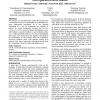Free Online Productivity Tools
i2Speak
i2Symbol
i2OCR
iTex2Img
iWeb2Print
iWeb2Shot
i2Type
iPdf2Split
iPdf2Merge
i2Bopomofo
i2Arabic
i2Style
i2Image
i2PDF
iLatex2Rtf
Sci2ools
101
Voted
CSCW
2012
ACM
2012
ACM
Social visualization and negotiation: effects of feedback configuration and status
We describe a social visualization system that monitors the vocal arousal levels of the participants in a simulated twoparty employment negotiation. In a 3x2 factorial experiment (N = 84), we manipulate two variables of interest for social visualization systems: the feedback configuration of the system’s display (participants receive self feedback vs. partner feedback vs. no feedback) and the status of the interactants (high vs. low). Receiving feedback about one's own arousal level has negative consequences for performance in and feelings about the negotiation. Receiving feedback about one's partner's arousal level interacts with status: high-status individuals benefit from the visualization, while low-status individuals do not. Author Keywords CSCW, social visualization, negotiation, arousal, feedback systems. ACM Classification Keywords H.5.3 Group and Organization Interfaces: Computersupported cooperative work General Terms Human Factors; Experimentation; Theory; ...
| Added | 21 Apr 2012 |
| Updated | 21 Apr 2012 |
| Type | Journal |
| Year | 2012 |
| Where | CSCW |
| Authors | Michael Nowak, Juho Kim, Nam Wook Kim, Clifford Nass |
Comments (0)

